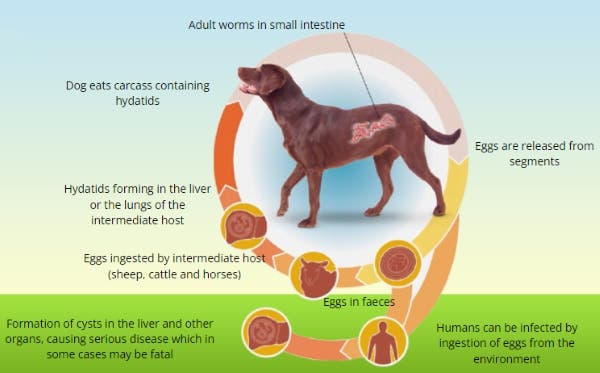What are tapeworms in pets?
Tapeworms are segmented worms that live in the small intestine of infected pets. Segments containing eggs are released from the worm and pass out into the pet’s faeces; they remain mobile for some time and can sometimes be seen in the pet’s faeces resembling tiny crawling rice grains.
There are four main types of tapeworm that tend to affect our pets:
- Dipylidium – this is the most common species, called the 'flea and lice tapeworm' which as the name suggests is contracted when pets swallow infected fleas or lice.
- Taenia tapeworm which can be caught by dogs or cats who scavenge or hunt, or pets fed on unprocessed raw food.
- Echinococcus granulosus, or sheep tapeworm, is caught by dogs who scavenge on sheep carcasses or who are fed unprocessed raw mutton. It is present in some areas of the UK - mostly in Wales, Welsh borders and Western Isles of Scotland. It can cause serious disease in people who are infected from eggs passed in the dog's faeces.
- Echinococcus multilocularis which is found abroad.

Tapeworms Factoid!
Some tapeworms can grow up to 5 METRES in length!
Because the most common type of tapeworm is transmitted by fleas, any cat or dog that has had fleas may be infected.
Dogs and cats at risk of tapeworms include:

The symptoms of tapeworms
You won’t always be aware if your pet has a form of tapeworm as there may not be any obvious symptoms.
You may occasionally, however, notice your pet spending more time than usual cleaning its bottom, since the egg-filled worm segments tend to irritate it as they pass through.
You may be able to pick up clues as to whether your pet has tapeworm - sometimes tiny segments (about the size of a grain of rice) can be found in their bedding.

Lifecycle and stages of tapeworms

NB This diagram is a simplification: the details differ depending on the species of tapeworm.
Infection stages: The incubation period for tapeworms is between 3 and 10 weeks depending on the species of tapeworm - that's the possible time lapse between your pet ingesting a tapeworm and starting to pass egg segments (these are not always visible).

Risks of tapeworms to humans
Tapeworms can pass from pets to people. Echinococcus granulosus, the tapeworm that only affects dogs, can cause a serious illness called hydatid disease in people, causing cysts to form in internal organs.
It can take up to 50 years for symptoms to become apparent although in some cases hydatid disease can prove fatal.
Spread of tapeworms in Europe
Tapeworm can be found right across the UK and Europe. Sheep tapeworm is found in the UK, it is most prevalent in Wales and the Hebrides.

How to get rid of and prevent tapeworms in pets
To treat and prevent infection with the flea tapeworm, rigorous flea control is crucial along with regular worming. Prevention of hunting and scavenging will help to prevent other tapeworms. If you choose to feed a raw diet then make sure it has been processed appropriately to minimise transfer of parasites.
Talk to your vet about which tapeworms your cat and dog might be at risk of and which products are best for your pet and their lifestyle to treat and prevent tapeworm infections.
Find out more about other worms in pets
This information was provided to you by Elanco Animal Health makers of Milbemax™.
Information regarding the side effects, precautions, warnings and contra-indications can be found in product packaging and leaflets; further information can also be found in the Summary of Product Characteristics. Use medicines responsibly (UK). Advice should be sought from the prescriber prior to use. Prescription decisions are for the person issuing the prescription alone.
Milbemax™, Elanco™ and the diagonal bar logo are trademarks of Elanco or its affiliates.
